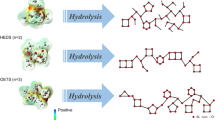Abstract
Hydrosilylation of nadic anhydride by tetramethyldisiloxane yielded 5,5’-(1,1,3,3-tetramethyl-1,1,3,3-disiloxanediayl)-bis-norborane-2,3-dicarboxylic anhydride (I), which further reacted with 4-aminophenol to form N,N’-bis(4-hydroxyphenyl)-5,5’-(1,1,3,3-tetramethyl-1,1,3,3-disiloxanediallyl)-binorborane-2,3-dicarboximide (II) reacted with epichlorohydrin to form siloxane- and imide-modified epoxy (i.e. N,N’-diglycidylether-bis-(4-phenyl)-5,5’-(1,1,3,3-tetramethyl-1,1,3,3-disloxanediallyl)-bis-norborane-2,3-dicarboximide (III) (Scheme 1). Various equivalent ratios of III/I for 1/1, 1/0.8 and Bisphenol F epoxy (830LVP DIC Co.)/I for 1/1, 1/0.8 were prepared and cured to produce four crosslinked materials. Thermal and dynamic mechanical properties were measured with TMA and DMA. Kinetic analysis was studied with dynamic DSC, which revealed a relatively lower curing activation energy of III/I systems, because the tertiary amine on the imide group catalyzed the curing reaction. III/I system also indicated moderate Tg, storage modulus but higher loss modulus as compared with Bisphenol F epoxy/I systems. These phenomena were interpreted by the fact that the siloxane group in III toughened the crosslinked materials. In addition, photos of SEM, carbon-mapping-SEM, oxygen-mapping SEM and siloxane-mapping-SEM indicated all homogeneity of these materials.
Similar content being viewed by others
References
H. Li, L. Wang, K. Jacob and C. P. Wong, J. Polym. Sci. Part A: Polym. Chem., 40, 1796 (2002).
J. G. Gao, D. L. Li, S. G. Shen and G. D. Liu, J. Appl. Polym. Sci., 83, 1586 (2002).
K. C. Cheng, S. Y. Yu and W. Y. Chiu, J. Appl. Polym. Sci., 83, 274 (2002).
G. H. Hsiue, H. F. Wei, S. J. Shiao, W. J. Kuo and Y. A. Sha, J. Polym. Degrad. Stab., 73, 309 (2001).
R. H. Lin, J. Polym. Sci. Part A: Polym. Chem., 38, 2934 (2000).
C. K. Riew, Ed., Rubber Toughened Plastics, Advances in Chemistry Series 222, American Chemical Society, Washington, DC, 1989.
S. Montarnal, J. P. Pascault and H. Sautereau, ibid., pp. 193–223.
W. D. Bascom and D. L. Hunston, ibid., pp. 135–172.
E. H. Rowe, G. R. Siebert and R. S. Drake, Mod. Plast., 49, 110 (1978).
L. T. Manzione, J. K. Gillham and C. A. McPherson, J. Appl. Polym. Sci., 26, 889 (1981).
J. R. Morgan, R. M. King and C. M. Walkup, Polymer, 24, 375 (1984).
A. C. Meeks, Polymer, 15, 675 (1974).
J. A. Manson and L. Sperling, Polymer Blends and Composites, Plenum, New York, 1983.
M. J. Abad, L. Barral, J. Cano, J. Lopez, P. Nogueira, C. Ramirez and A. Torres, Eur. Polym. J., 37, 1613 (2001).
J. Y. Lee, M. J. Shim and S. W. Kim, J. Appl. Polym. Sci., 81, 479 (2001).
A. A. Kumar, M. Alagar and R. M. V. G. K. Rao, Polymer, 43, 693 (2002).
M. Ochi and S. Shimaoka, Polymer, 40, 1305 (1999).
A. F. Yee and R. A. Pearson, J. Mater. Sci., 21, 2475 (1986).
C. B. Bucknall and I. K. Partridge, Polym. Engng. Sci., 26, 54 (1986).
W. D. Bascom, R. L. Cottington, R. L. Jones and P. Peyser, J. Appl. Polym. Sci., 19, 2425 (1975).
J. N. Sultan and F. J. McGarry, Polym. Eng. Sci., 13, 29 (1973).
A. A. Kumar, M. Alagar and R. M. V. G. K. Ras, J. Appl. Polym. Sci., 81, 1330 (2001).
V. J. Eddy, J. E. Hallgren and E. Robert, J. Polym. Sci., Part A: Polym. Chem., 28, 2417 (1990).
W. J. Wang, L. H. Perng, G. H. Hsiue and F. C. Chang, Polymer, 41, 6113 (2000).
IPC-TM-650, The Institute for Interconnecting and Packaging Electronic Circuits, 2215 Sanders Road, Northbrook, IL 60062-6135, USA.
H. E. Kissinger, Analytical Chem., 29, 1703 (1957).
C. P. R. Nair, K. Krishnan and K. N. Ninan, Thermochim. Acta, 39, 61 (2000).
L. F. Yang, K. D. Yao and W. Koh, J. Appl. Polym. Sci., 73, 1501 (1998).
K. J. Saunders, Ed., Organic Polymer Chemistry, Chapman and Hall, London, 1973, Ch. 16, p. 375.
L. Shechter and J. Wynstra, Ind. Eng. Chem., 48, 86 (1956).
A. Moroni, J. Mijovic and E. M. Pearce, J. Appl. Polym. Sci., 32, 3761 (1986).
W. Lynch, Ed., Handbook of Silicone Rubbers Fabrication, Van Nostrand Reinhold, New York, 1978, p. 9.
Author information
Authors and Affiliations
Corresponding author
Rights and permissions
About this article
Cite this article
Li, HT., Lin, MS., Chuang, HR. et al. Siloxane- and Imide-modified Epoxy Resin Cured with Siloxane-containing Dianhydride. J Polym Res 12, 385–391 (2005). https://doi.org/10.1007/s10965-005-1766-9
Received:
Accepted:
Issue Date:
DOI: https://doi.org/10.1007/s10965-005-1766-9




